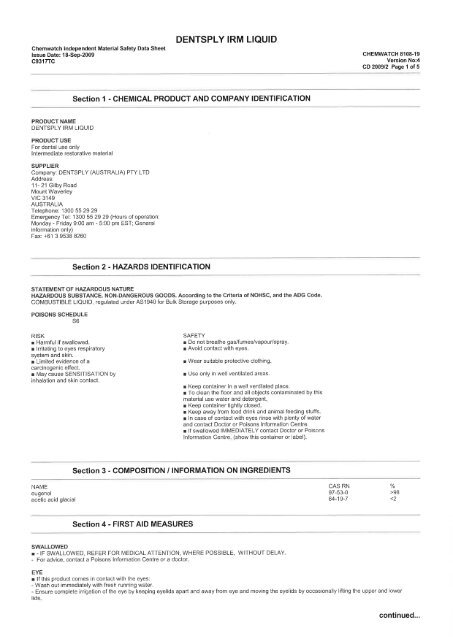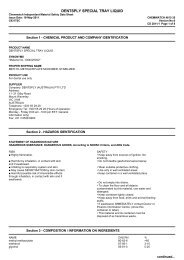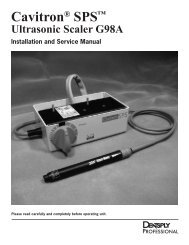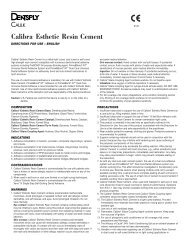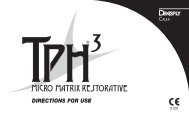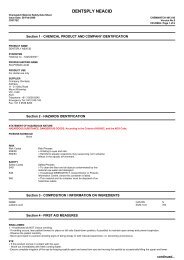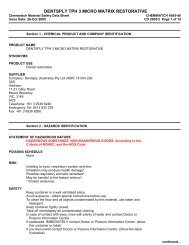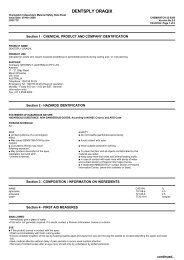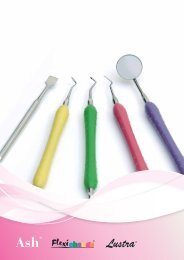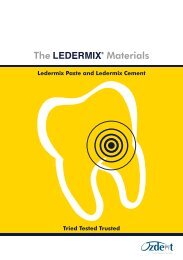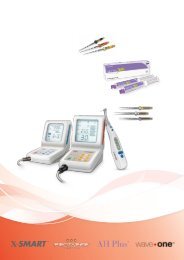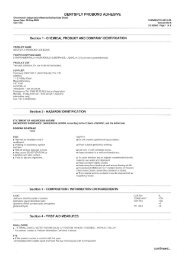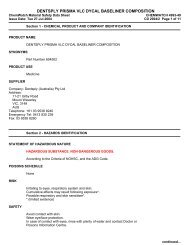DENTSPLY IRM LIQUID
DENTSPLY IRM LIQUID
DENTSPLY IRM LIQUID
Create successful ePaper yourself
Turn your PDF publications into a flip-book with our unique Google optimized e-Paper software.
Chemwatch lndependent Material Safety Data Sheet<br />
lssue Date: 1 8-Sep-2009<br />
c9317TC<br />
<strong>DENTSPLY</strong> <strong>IRM</strong> <strong>LIQUID</strong><br />
CHEMWATCH 8108-19<br />
Vers¡on No:4<br />
CD 200912 Page 1 of 5<br />
Section I - CHEMICAL PRODUCT AND COMPANY IDENTIFICATION<br />
PRODUCT NAME<br />
<strong>DENTSPLY</strong> <strong>IRM</strong> <strong>LIQUID</strong><br />
PRODUCT USE<br />
For dental use only<br />
lntermediate restorative material<br />
SUPPLIER<br />
Company: <strong>DENTSPLY</strong> (AUSTRALIA) PTY LTD<br />
Address:<br />
1 1- 21 Gilby Road<br />
Mount Waverley<br />
vtc 3149<br />
AUSTRALIA<br />
Telephone: 1300 55 29 29<br />
Emergency Tel: 1300 55 29 29 (Hours of operation:<br />
Monday - Friday 9:00 am - 5:00 pm EST; General<br />
information only)<br />
Fax: +61 3 9538 8260<br />
Section 2 - HAZARDS IDENTIFICATION<br />
STATEMENT OF HAZARDOUS NATURE<br />
HAZARDOUS SUBSTANCE. NON-DANGEROUS GOODS. According to the Criteria of NOHSC, and the ADG Code.<br />
COMBUSTIBLE L|QUlD, regulated under 4S1940 for Bulk Storage purposes only<br />
POISONS SCHEDULE<br />
5t<br />
RISK<br />
r Harmful if swallowed<br />
I lrritating to eyes respiratory<br />
system and skin.<br />
r Limited evidence of a<br />
carcinogenic effect.<br />
r lvlay cause SENSITISATION by<br />
inhalation and skin contact.<br />
SAFETY<br />
r Do not breathe gas/fumes/vapour/spray.<br />
r Avoid contact with eyes.<br />
r Wear suitable protective clothing<br />
r Use only in well ventilated areas.<br />
r Keep container in a well ventilated place.<br />
I To clean the floor and all objects contaminated by this<br />
material use water and detergent<br />
I Keep container tightly closed<br />
r Keep away from food drink and animal feeding stuffs<br />
I ln case of contact with eyes rinse with plenty of water<br />
and contact Doctor or Poisons lnformation Centre.<br />
r lf swallowed IMMEDIATELY contact Doctor or Poisons<br />
lnformation Centre (show this container or label).<br />
Section 3 - COMPOSITION / INFORMATION ON INGREDIENTS<br />
NAME<br />
eugenol<br />
acetic acid glacial<br />
CAS RN %<br />
97-53-0 >98<br />
64-19-7
Chemwatch lndependent Material Safety Data Sheel<br />
lssue Date: 18-Sep-2009<br />
c931 7TC<br />
<strong>DENTSPLY</strong> <strong>IRM</strong> <strong>LIQUID</strong><br />
CHEMWATCH 8108I9<br />
Version No:4<br />
CD 200912 Page 2 of 5<br />
Section 4 - FIRST AID MEASURES<br />
SKIN<br />
r lf skin contact occurs:<br />
- lmmediately remove all contaminated clothing, including footwear<br />
- Flush skin and hair with running water (and soap if available).<br />
INHALED<br />
r - lf fumes or combustion products are inhaled remove from contaminated area<br />
- Lay patient down. Keep warm and rested<br />
NOTES TO PHYSICIAN<br />
¡ Treat symptomatically<br />
Section 5 - FIRE FIGHTING MEASURES<br />
EXTINGUISHING MEDIA<br />
r - Foam<br />
- Dry chemical powder.<br />
FIRE FIGHTING<br />
r - Alert Fire Brigade and tell them location and nature of hazard<br />
- Wear full body protective clothing with breathing apparatus<br />
FIRE/EXPLOSION HAZARD<br />
r - Combustible<br />
- Slight fire hazard when exposed to heat or flame.<br />
Combustion products ¡nclude: carbon dioxide (CO2), other pyrolysis products typicaì of burning organic material<br />
May emit poisonous fumes.<br />
May emit corrosive fumes<br />
CARE: Water in contact w¡th hot liquid may cause foaming and a steam explosion with wide scattering of hot oil and possible severe burns Foaming may<br />
cause overflow of containers and may result in possible fire.<br />
FIRE INCOMPATIBILITY<br />
r -Avoid contamination with oxidising agents ie nitrates, oxidising acids, chlorine bleaches, pool chlorine etc. as ignition may result<br />
HAZCHEM: None<br />
Personal Protective Equipment<br />
Gas tight chemical resistant suit.<br />
Section 6 - ACCIDENTAL RELEASE MEASURES<br />
MINOR SPILLS<br />
I - Remove all ignition sources<br />
- Clean up all spills immediately<br />
MAJOR SPILLS<br />
r Moderate hazard<br />
- Clear area of personnel and move upwind.<br />
- Alert Fire Brigade and tell them location and nature of hazard<br />
Personal Protect¡ve Equipment advice is contained in Section I of the MSDS.<br />
Section 7 - HANDLING AND STORAGE<br />
PROCEDURE FOR HANDLING<br />
r - DO NOT allow clothing wet with material to stay in contact with skin<br />
- Avoid all personal contact, ¡ncluding inhalation.<br />
- Wear protective clothing when risk of exposure occurs<br />
SUITABLE CONTAINER<br />
r - Glass container is su¡table for laboratory quantities<br />
- Metal can or drum<br />
- Packaging as recommended by manufacturer.<br />
STORAGE INCOMPATIBILITY<br />
I - Avoid reaction with ox¡dising agents.<br />
STORAGE REQUIREMENTS<br />
r - Store in original containers.<br />
- Keep containers securely sealed.<br />
cont¡nued...
Chemwatch lndependent Mater¡al Safety Data Sheet<br />
lssue Date: 18-Sep-2009<br />
c931 7TC<br />
<strong>DENTSPLY</strong> <strong>IRM</strong> <strong>LIQUID</strong><br />
CHEMWATCH 8108.19<br />
Version No:4<br />
CD 2009/2 Page 3 of5<br />
Section 8 - EXPOSURE CONTROLS / PERSONAL PROTECTION<br />
EXPOSURE CONTROLS<br />
Source<br />
Material<br />
TWA ppm TWA mg/m3 STEL ppm STEL mg/m3<br />
Australia Exposure<br />
Standards<br />
acetic acid glacial<br />
(Acetic acid)<br />
10<br />
25<br />
15 5t<br />
The following materials had no OELs on our records<br />
. eugenol:<br />
CAS:97- 53- 0<br />
PERSONAL PROTECTION<br />
RESPIRATOR<br />
Type ABNO-P Filter of sufficient capacity<br />
EYE<br />
I - Safety glasses with side shields<br />
- Chemical goggles.<br />
HANDS/FEET<br />
¡ - Wear chemical protective gloves, eg PVC<br />
- Wear safety footwear or safety gumboots, eg Rubber.<br />
NOTE:<br />
- The material may produce sk¡n sensitisation ¡n predisposed individuals Care must be taken, when removing gloves and other protective equ¡pment, to<br />
avoid all possible skin contact.<br />
- Contaminated leather items, such as shoes, belts and watch-bands should be removed and destroyed<br />
OTHER<br />
I - Overalls.<br />
- P V.C apron.<br />
ENGINEERING CONTROLS<br />
r Local exhaust ventilation usually required lf risk of overexposure exists, wear approved respirator.<br />
Section I - PHYSICAL AND CHEMICAL PROPERTIES<br />
APPEARANCE<br />
Colorless or pale yellow liquid with clove oil odour;<br />
does not mix with water<br />
PHYSICAL PROPERTIES<br />
Liquìd<br />
Does not mix w¡th water.<br />
Sinks in water<br />
Boiling Range (T):254<br />
lvlelting Range (C): - 10 Specifìc Gravity (water=1 ): 1 .06<br />
Solubility in water (g/L): lmmiscible<br />
pH (as supplied): Not Available<br />
pH (1% solution): Not Available<br />
Vapour Pressure (kPa): Negligible<br />
Evaporation Rate: Not Available<br />
l\¡lolecular Weight: Not Applicable<br />
Volatile Component (%vol): Not Available<br />
Relative Vapour Density (air=1 ): Not Ava¡lable Flash Point (C): I 10<br />
Lower Explosive Limit (%): Not Ava¡lable<br />
Autoignition Temp (C): Not Available<br />
State: Liquid<br />
Upper Explosive L¡mit (%): Not Available<br />
Decomposition Temp (C): Not Available<br />
Viscosity: Not Available<br />
Section l0 - CHEMICAL STABILITY AND REACTIVITY INFORMATION<br />
CONDITIONS CONTRIBUTING TO INSTABILITY<br />
I - Presence of incompatible materials<br />
- Product is considered stable.<br />
For incompatible materials - refer to Section 7 - Handlìng and Storage<br />
cont¡nued...
Chemwatch lndependent Material Safety Data Sheet<br />
lssue Date: 18-Sep-2009<br />
c931 7TC<br />
<strong>DENTSPLY</strong> <strong>IRM</strong> <strong>LIQUID</strong><br />
CHEMWATCH 8108.19<br />
Version No:4<br />
CD 200912 Page 4 of 5<br />
Section l1 - TOXICOLOGICAL INFORMATION<br />
POTENTIAL HEALTH EFFECTS<br />
ACUTE HEALTH EFFECTS<br />
CHRONIC HEALTH EFFECTS<br />
¡ Harmful if swallowed. r Limited evidence of a carcinogenic effect<br />
r lrritating to eyes, respiratory system and<br />
skin<br />
contact<br />
TOXICITY AND IRRITATION<br />
¡ Not available Referto individual constituents.<br />
r May cause SENSITISATION by inhalation and skin<br />
EUGENOL:<br />
¡ unless otherwise specifìed data extracted from RTECS - Register of Toxic Effects of Chemical Substances.<br />
TOXICITY<br />
IRRITATION<br />
Oral (rai) LD50: 1930 mg/kg<br />
Skin (human) 40 mg/24h - N4ild<br />
Skin (man): 16 mg/48h - Moderate<br />
Skin (rabbit): 100 mgl24h- SEVERE<br />
¡ Contact allerg¡es quickly manifest themselves as contact eczema, more rarely as urticaria or Quincke's oedema The pathogenesis of contact eczema<br />
involves a cell-mediated (T lymphocytes) immune reaction of the delayed type<br />
Asthma-like symptoms may continue for months or even years after exposure to the material ceases. This may be due to a non-allergenic condition known<br />
as reactive airways dysfunction syndrome (RADS) which can occur following exposure to high levels of highly ¡rritating compound<br />
Allergic react¡ons which develop in the respiratory passages as bronchial asthma or rhinoconjunctivit¡s, are mostly the result of reactions of the<br />
allergen with specific antibodies of the lgE class and belong in their reaction rates to the manifestation of the immediate type. ln addition to the<br />
allergen-specific potential for causing respiratory sensitisation, the amount of the allergen, the exposure period and the genetically determined<br />
disposition of the exposed person are likely to be decisive<br />
Particular attention ¡s drawn io so-called atopic diathesis which is characterised by an increased susceptibility to allergic rhinitis, allergic<br />
bronchial asthma and atopic eczema (neurodermatitis) which is associated with increased lgE synthesis<br />
Exogenous allergic alveolitis is induced essentially by allergen specific immune-complexes of the lgG type; cell-med¡ated reactions (T lymphocytes)<br />
maybeinvolved Suchallergyisofthedelayedtypewithonsetuptofourhoursfollowingexposure.<br />
The malerial may produce severe skin irritation after prolonged or repeated exposure, and may produce a contact dermatitis (nonallergic). Th¡s form<br />
of dermatitis is often characterised by skin redness (erythema) thickening of the epidermis<br />
The substance is classif¡ed by IARC as Group 3:<br />
NOT classifiable as to its carcinogenicity to humans<br />
Evidence of carcinogenicity may be inadequate or limited in animal testing<br />
Equivocal tumorigen by RTECS criteria<br />
ACETIC ACID GLACIAL:<br />
¡ unless otherwise specified data extracted from RTECS - Registerof Toxic Effects of Chemical Substances.<br />
TOXICITY<br />
IRRITATION<br />
Oral (human)TDLo: 1.47 mg/kg<br />
Skin (human):50m9/24hr - M¡ld<br />
Unreport (man) LDLo: 308 mg/kg<br />
Skin (rabb¡t):525m9 (open)- SEVERE<br />
Oral (rat) LD50: 3310 mg/kg<br />
Eye (rabbit): 0 05mg (open)- SEVERE<br />
lnhalation (human) TCLo: 816 ppm/3 min<br />
Inhalation (rat) LCLo: 16000 ppm/4 hr<br />
Dermal (rabbit) LD50: 1060 mg/kg<br />
r Asthma-like symptoms may continue for months or even years after exposure to the material ceases This may be due to a non-allergenic condition<br />
known as reactive airways dysfunction syndrome (RADS) which can occur following exposure to high levels of highly irritating compound<br />
The materiaì may produce severe irritation to the eye causing pronounced inflammation. Repeated or prolonged exposure to irritants may produce<br />
conjunctiv¡tis<br />
The material may produce severe skin irritation after prolonged or repeated exposure, and may produce a contact dermatitis (nonallergic) This form<br />
of dermatitis is often characterised by skin redness (erythema) thickening of the epidermis<br />
NOAELs following repeated exposure to acetic acid and its salts range |rom21O mg/kg bw/day (2-4 month acetic acid drinking water study; systemic<br />
toxicity) to 3600 mg/kg bw/day (acetic acid, sodium salt, 4 week dietary study; no effects reported). Signs of irritation/corrosion at the site of<br />
contact as well as systemic toxicity have been reported<br />
CARCINOGEN<br />
Eugenol<br />
lnternational Agency<br />
for Research on Cancer<br />
(IARC) Carcinogens<br />
Group<br />
Section l2 - ECOLOGICAL INFORMATION<br />
No data<br />
Ecotoxicity<br />
lngredient Persistence: Persistence. Bioaccumulat Mob¡lity<br />
Water/Soil A¡r ion<br />
Dentsply lRlV Liquid<br />
eugenol<br />
acetic acid glacial<br />
No data<br />
No data<br />
No data<br />
continued...
Chemwatch lndependent Material Safety Data Sheet<br />
lssue Date: 18-Sep-2009<br />
c9317TC<br />
<strong>DENTSPLY</strong> <strong>IRM</strong> <strong>LIQUID</strong><br />
CHEMWATCH 8108-19<br />
Version No:4<br />
CO200912 Page5of5<br />
Section I3 - DISPOSAL CONSIDERATIONS<br />
r - Recycle wherever possible or consult manufacturer for recycling options<br />
- Consult State Land Waste Authority for disposal<br />
Section 14 - TRANSPORTATION INFORMATION<br />
Labels Required: COMBUSTIBLE L|QUlD, regulated under AS1940 for Bulk Storage purposes only<br />
HAZCHEM: None (ADG7)<br />
NOT REGULATED FOR TRANSPORT OF DANGEROUS GOODS: ADG7, UN, IATA, IMDG<br />
Section 15 - REGULATORY INFORMATION<br />
POISONS SCHEDULE: 56<br />
REGULATIONS<br />
Regulations for ingredients<br />
eugenol (GAS: 97-53-0) is found on the following regulatory lists;<br />
acetic acid glacial (CAS: 64-19-7) is found on the following regulatory lists;<br />
Production Volume (HPV) Chemicals"<br />
No data for Dentsply <strong>IRM</strong> Liquid (CW: 8108-19)<br />
Section 16 - OTHER INFORMATION<br />
Denmark Advisory list for selfclass¡f¡cat¡on of dangerous substances<br />
Substance<br />
CAS Suggested codes<br />
eugenol<br />
97- 53- 0 Xn; R22 Mut3;<br />
R40 R43<br />
r Classification of the preparation and its individual components has drawn on official and authoritative sources as well as independent review by<br />
the Chemwatch Classification committee us¡ng available literature references.<br />
A list of reference resources used to assist the committee may be found at:<br />
www.chemwatch neVreferences<br />
r The (M)SDS is a Hazard Communication tool and should be used to assist in the Risk Assessment Many factors determine whether the reported Hazards<br />
are Risks in the workplace or other settings<br />
This document is copyright. Apañ from any fair dealing for the purposes of private study, research, review or<br />
criticism, as permitted under the Copyright Act, no pañ may be reproduced by any process without written<br />
permission from CHEMWATCH. TEL (+61 3) 9572 4700.<br />
lssue Date: 1 8-Sep-2009<br />
Print Date: 1 8-Sep-2009<br />
Ih,s is ü?e end of the MSDS
Chemwatch lndependent Material Safety Data Sheet<br />
lssue Date: 17-Sep-2009<br />
c9317TC<br />
<strong>DENTSPLY</strong> <strong>IRM</strong> POWDER<br />
CHEMWATCH 8108-20<br />
Version No:4<br />
CD 2009/2 Page 'l of 5<br />
Section I - CHEMICAL PRODUCT AND COMPANY IDENTIFICATION<br />
PRODUCT NAME<br />
<strong>DENTSPLY</strong> <strong>IRM</strong> POWDER<br />
SYNONYMS<br />
"intermediate restorat¡ve mater¡al"<br />
PRODUCT USE<br />
For dental use only<br />
SUPPLIER<br />
Company: <strong>DENTSPLY</strong> (AUSTRALIA) PTY LTD<br />
Address:<br />
1 1- 21 Gilby Road<br />
Mount Waverley<br />
vtc 3149<br />
AUSTRALIA<br />
Telephone: 1300 55 29 29<br />
Emergency Tel: 1300 55 29 29 (Hours of operation:<br />
Monday - Friday 9:00 am - 5:00 pm EST; General<br />
information only)<br />
Fax: +61 3 9538 8260<br />
Section 2 - HAZARDS IDENTIFICATION<br />
STATEMENT OF HAZARDOUS NATURE<br />
HAZARDOUS SUBSTANCE. NON-DANGEROUS GOODS. According to the Cr¡ter¡a of NOHSC, and the ADG Code.<br />
POISONS SCHEDULE<br />
None<br />
RISK<br />
r Very toxic to aquatic organisms may cause<br />
long- term adverse effects in the aquatic<br />
environment<br />
SAFEry<br />
I Do not breathe dust.<br />
r Avoid contact with skin<br />
r Wear eye/face protection<br />
r Use only in well ventilated areas<br />
r Keep container in a well ventilated place<br />
r To clean the floor and all objects contaminated<br />
by this material use water and detergent.<br />
r This material and its container must be<br />
disposed of in a safe way.<br />
r ln case of contact with eyes rinse with plenty<br />
of water and contact Doctor or Poísons<br />
lnformation Centre<br />
r Use appropriate container to avoid<br />
environmental contamination.<br />
r Avoid release to the environment Refer to<br />
special ¡nstructions/Safety data sheets.<br />
Section 3 - COMPOSITION / INFORMATION ON INGREDIENTS<br />
NAME<br />
zinc oxide<br />
other ingredients determined not to be hazardous<br />
CAS RN<br />
IO<br />
1314-13-2 50-100<br />
NotSpec<br />
Section 4 - FIRST AID MEASURES<br />
SWALLOWED<br />
r - lf swallowed do NOT induce vomiting<br />
- lf vomiting occurs, lean patient foruard or place on left side (head-down position, if possible) to mainta¡n open airway and prevent aspiration<br />
EYE<br />
r lf this product comes in contact with the eyes:<br />
cont¡nued...
Chemwatch lndependent Material Safety Data Sheet<br />
lssue Date: 17-Sep-2009<br />
c9317TC<br />
<strong>DENTSPLY</strong> <strong>IRM</strong> POWDER<br />
CHEMWATCH 8108-20<br />
Version No:4<br />
CD 200912 Page 2 of 5<br />
Section 4 - FIRST AID MEASURES<br />
- Wash out immediately with fresh running water<br />
- Ensure complete irrigation of the eye by keeping eyelids apart and awayfrom eye and moving the eyelids by occasionally lifting the upper and lower<br />
lids.<br />
SKIN<br />
I lf skin contact occurs:<br />
- lmmediately remove all contaminated clothing, including footwear.<br />
- Flush skin and hair with running water (and soap if available)<br />
INHALED<br />
r - lf dust is inhaled, remove from contaminated area<br />
- Encourage patient to blow nose to ensure clear breathing passages<br />
NOTES TO PHYSICIAN<br />
r - Absorption of zinc compounds occurs in the small intestine<br />
- The metal is heavily protein bound.<br />
Section 5 - FIRE FIGHTING MEASURES<br />
EXTINGUISHING MEDIA<br />
r - Water spray or fog<br />
- Foam<br />
FIRE FIGHTING<br />
r - Alert Fire Br¡gade and tell them location and nature of hazard.<br />
- Wear breathing apparatus plus protective gloves for fire only<br />
FIRE/EXPLOSION HAZARD<br />
r - Non combustible<br />
- Not considered a significant fire risk, however coniainers may burn<br />
Decomposition may produce toxic fumes of: metal oxides.<br />
May emit poisonous fumes.<br />
May emit corrosive fumes<br />
FIRE INCOMPATIBILITY<br />
r None known.<br />
HAZCHEM: None<br />
PERSONAL PROTECTION<br />
Glasses:<br />
Not normally required<br />
Gloves:<br />
When handling Iarger quantities:<br />
General purpose rubber glove,<br />
Respirator:<br />
Particulate<br />
Section 6 - ACCIDENTAL RELEASE MEASURES<br />
MINOR SPILLS<br />
I - Remove all ignition sources<br />
- Clean up all spills immediately<br />
MAJOR SPILLS<br />
r Moderate hazard<br />
- CAUTION:Advise personnel ¡n area.<br />
- Alert Emergency Services and tell them location and nature of hazard.<br />
Personal Protect¡ve Equipment advice is contained in Section I of the MSDS.<br />
Section 7 - HANDLING AND STORAGE<br />
PROCEDURE FOR HANDLING<br />
r - Avoid all personal contact, including inhalation.<br />
- Wear protective clothing when risk of exposure occurs<br />
SUITABLE CONTAINER<br />
r - Polyethylene or poìypropylene container.<br />
- Check all containers are clearly labelled and free from leaks<br />
cont¡nued...
Chemwatch Independent Material Safety Data Sheet<br />
lssue Date: 17-Sep-2009<br />
c931 7TC<br />
STORAGE INCOMPATIBILITY<br />
¡ - Avoid reaction with oxidising agents.<br />
STORAGE REQUIREMENTS<br />
r - Store in original containers<br />
- Keep containers securely sealed<br />
<strong>DENTSPLY</strong> <strong>IRM</strong> POWDER<br />
CHEMWATCH 8,I08-20<br />
Version No:4<br />
CD 20Ûgl2 Page 3 of 5<br />
Sect¡on 7 - HANDLING AND STORAGE<br />
Section I - EXPOSURE CONTROLS / PERSONAL PROTECTION<br />
EXPOSURE CONTROLS<br />
Source<br />
Material<br />
TWA mg/m'<br />
STEL mg/m3<br />
Australia Exposure Standards<br />
Austral¡a Exposure Standards<br />
zinc oxide (Zinc oxide (dust)<br />
(a))<br />
zinc oxide (Zinc oxide (fume))<br />
10<br />
5 10<br />
PERSONAL PROTECTION<br />
RESPIRATOR<br />
Particulate<br />
EYE<br />
r No special equipment for minor exposure i e. when handling small quantities<br />
HANDS/FEET<br />
r No special equipment needed when handl¡ng small quantities.<br />
OTHERWISE: Wear general protect¡ve gloves, eg.<br />
OTHER<br />
I - Overalls<br />
-PVC apron.<br />
r - Respirators may be necessary when engineering and administrative controls do not adequateiy prevent exposures<br />
- The decision to use resp¡ratory protection should be based on professionaljudgment that takes into account toxicity information, exposure<br />
measurement data, and frequency and likelihood of the worker's exposure - ensure users are not subject to high thermal loads which may result in heat<br />
stress or distress due to personal protect¡ve equipment (powered, positive flow, full face apparatus may be an option)<br />
ENGINEERING CONTROLS<br />
r Local exhaust ventilation usually required. lf r¡sk of overexposure exists, wear approved respirator.<br />
Section 9 - PHYSICAL AND CHEMICAL PROPERTIES<br />
APPEARANCE<br />
White powder with a faint odour, insolubie in water.<br />
PHYSICAL PROPERTIES<br />
Does not mix with water<br />
Molecular Weight: Not Applicable<br />
Melting Range (C): Not Available<br />
Solubility in water (g/L): lmmiscible<br />
pH (1% solution): Not Applicable<br />
Volat¡le Component (%vol): Not Appl¡cable<br />
Relative Vapour Density (air=1): Not Applicable<br />
Lower Explosive Limit (%): Not Applicable<br />
Autoignit¡on Temp (C): Not Available<br />
State: Divided Solid<br />
Boiling Range (C): Not Applicable<br />
Specific Gravity (water=1): Not Available<br />
pH (as supplied): Not Applicable<br />
Vapour Pressure (kPa): Not Appl¡cable<br />
Evaporation Rate: Not Applicable<br />
Flash Point (C): Not Applicable<br />
Upper Explosive Limit (%): Not Applicable<br />
Decomposit¡on Temp (C): Not Available<br />
Viscosity: Not Applicable<br />
Section 10 - CHEMICAL STABILITY AND REACTIVITY INFORMATION<br />
CONDITIONS CONTRIBUTING TO INSTABILITY<br />
r - Presence of incompatible materials<br />
- Product is considered stable<br />
For incompatible materials - refer to Section 7 - Handling and Storage<br />
cont¡nued...
Chemwatch lndependent Material Safety Data Sheet<br />
lssue Date: 17-Sep-2009<br />
c931 7TC<br />
<strong>DENTSPLY</strong> <strong>IRM</strong> POWDER<br />
cHEMWATCH 8108-20<br />
Version No:4<br />
CD 200912 Page 4 of 5<br />
Section 1l - TOXIGOLOGICAL INFORMATION<br />
POTENTIAL HEALTH EFFECTS<br />
ACUTE HEALTH EFFECTS<br />
I Not applicable.<br />
CHRONIC HEALTH EFFECTS<br />
r Not applicable.<br />
TOXICITY AND IRRITATION<br />
r Not available. Refer to individual const¡tuents.<br />
ZINC OXIDE:<br />
r unless othen¡yise specified data extracted from RTECS - Register of Toxic Effects of Chemical Substances<br />
TOXICITY<br />
Oral (human) LDLo: 500 mg/kg<br />
IRRITATION<br />
Skin : Mild<br />
lnhalation (human) TCLo: 600 mg/m3<br />
Eye : Mild<br />
Oral (mouse) LD50: 7950 mg/kg<br />
Oral (Rat) LD50: >8437 mg/kg<br />
r The material may cause skin irritation after prolonged or repeated exposure and may produce a contact dermatitis (nonallergic) This form of<br />
dermatitis is often characterised by skin redness (erythema) and swelling epidermis<br />
Section l2 - ECOLOGICAL INFORMATION<br />
Very toxic to aquatic organisms, may cause long{erm adverse effects in the aquatic environment.<br />
Avoid release to the environment<br />
Refer to spec¡al instructions/ safety data sheets<br />
Ecotoxicity<br />
lngredient Persistence: Persistence: Bioaccumulat Mobility<br />
Water/Soil Air ¡on<br />
Dentsply <strong>IRM</strong> Powder<br />
zinc oxide<br />
No data<br />
No data<br />
Section l3 - DISPOSAL CONSIDERATIONS<br />
r - Recycle wherever possible or consult manufacturer for recycling opttons<br />
- Consult State Land Waste Management Authority for disposal.<br />
HAZCHEM: None (ADG7)<br />
Section 14 - TRANSPORTATION INFORMATION<br />
NOT REGULATED FOR TRANSPORT OF DANGEROUS GOODS: ADG7, UN, IATA, IIVDG<br />
Section 15 - REGULATORY INFORMATION<br />
POISONS SCHEDULE: None<br />
REGULATIONS<br />
Regulations for jngredients<br />
zinc oxide (CAS: 1314-13-2) is found on the following regulatory lists;<br />
in l¡sted products","OECD Representative L¡st of High Production Volume (HPV) Chemicals"<br />
No data for Dentsply <strong>IRM</strong> Powder (CW: 8108-20)<br />
cont¡nued...
Chemwatch lndependent Material Safety Data Sheet<br />
lssue Date: 17-Sep-2009<br />
c93l7TC<br />
<strong>DENTSPLY</strong> <strong>IRM</strong> POWDER<br />
CHEMWATCH 8108-20<br />
Version No:4<br />
CD 2009/2 Page 5 of5<br />
Section 16 - OTHER INFORMATION<br />
r C¡ass¡fication of the preparation and ¡ts individual components has drawn on official and auihoritative sources as well as independent review by<br />
the Chemwatch Classifìcation committee usìng available literature references.<br />
A list of reference resources used to assist the committee may be found at:<br />
www chemwatch.neureferences.<br />
r The (M)SDS is a Hazard Communication tool and should be used to assist in the Risk Assessment Many factors determine whether the reported Hazards<br />
are Risks ¡n the workplace or other settings<br />
This document is copyright. Apart from any fair dealing for the purposes of pr¡vate study, research, review or<br />
citicísm, as permitted under the Copyright Act, no pañ may be reproduced by any process without wr¡tten<br />
permission from CHEMWATCH. TEL (+61 3) 9572 4700<br />
lssue Date: 1 7-Sep-2009<br />
Print Date: 1 8-Sep-2009<br />
This is the end of the MSDS.


